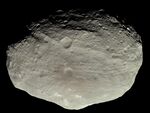Astronomy:2011 CQ1
From HandWiki
Short description: 2nd closest non-impacting Earth approach
| Discovery[1] | |
|---|---|
| Discovered by | Catalina Sky Survey Richard A. Kowalski |
| Discovery date | 4 February 2011 |
| Designations | |
| 2011 CQ1 | |
| Minor planet category | |
| Orbital characteristics[2] | |
| Epoch 13 January 2016 (JD 2457400.5) | |
| Uncertainty parameter 5 | |
| Observation arc | 12.4 hours[3] (35 observations used) |
| |{{{apsis}}}|helion}} | 1.0087 astronomical unit|AU (150.90 Gm) (Q) |
| |{{{apsis}}}|helion}} | 0.66454 AU (99.414 Gm) (q) |
| 0.83661 AU (125.155 Gm) (a) | |
| Eccentricity | 0.20567 (e) |
| Orbital period | 0.77 yr (279.5 d) |
| Mean anomaly | 18.607° (M) |
| Mean motion | 1.2880°/day (n) |
| Inclination | 5.2445° (i) |
| Longitude of ascending node | 315.23° (Ω) |
| 335.40° (ω) | |
| Earth MOID | 0.000166307 AU (24,879.2 km) |
| Jupiter MOID | 4.09715 AU (612.925 Gm) |
| Physical characteristics | |
| Dimensions | ~2 meters (79 in) |
| Apparent magnitude | 14.2 (2011 peak)[4] |
| Absolute magnitude (H) | 32.1[2] |
2011 CQ1 is a meteoroid discovered on 4 February 2011 by Richard A. Kowalski, at the Catalina Sky Survey.[1] On the same day the meteoroid passed within 0.85 Earth radii (5,480 kilometers (3,410 mi)) of Earth's surface, and was perturbed from the Apollo class to the Aten class of near-Earth objects.[5] With a relative velocity of only 9.7 km/s,[2] had the asteroid passed less than 0.5 Earth radii from Earth's surface, it would have fallen as a brilliant fireball. The meteoroid is between 80 centimeters (31 in) and 2.6 meters (100 in) wide.[5] The meteoroid was removed from the Sentry Risk Table on 5 February 2011.[6]
| Parameter | Epoch | aphelion (Q) |
perihelion (q) |
Semi-major axis (a) |
eccentricity (e) |
Period (p) |
inclination (i) |
Longitude ascending node (Ω) |
Mean anomaly (M) |
Argument of perihelion (ω) |
|---|---|---|---|---|---|---|---|---|---|---|
| Units | AU | (days) | (°) | |||||||
| Pre-flyby | 2011-Jan-26 | 1.347 | 0.9096 | 1.128 | 0.1940 | 437.9 | 1.073° | 135.4° | 310.9° | 58.59° |
| Post-flyby | 2011-Feb-08 | 1.009 | 0.6624 | 0.8360 | 0.2076 | 279.2 | 5.296° | 315.4° | 220.6° | 335.1° |
It was not until 2020 QG on 16 August 2020 that a non-impacting closer approach to Earth was observed.
See also
References
- ↑ 1.0 1.1 "MPEC 2011-C12 : 2011 CQ1". IAU Minor Planet Center. 2011-02-04. http://www.minorplanetcenter.net/mpec/K11/K11C12.html. Retrieved 2013-02-27. (K11C01Q)
- ↑ 2.0 2.1 2.2 2.3 "JPL Close-Approach Data: (2011 CQ1)". https://ssd.jpl.nasa.gov/tools/sbdb_lookup.html#/?sstr=2011CQ1&view=OPC.
- ↑ "2011 CQ1". Minor Planet Center. http://www.minorplanetcenter.net/db_search/show_object?object_id=2011+CQ1. Retrieved 2020-08-21.
- ↑ "2011 CQ1 Ephemerides for 4 February 2011". NEODyS (Near Earth Objects – Dynamic Site). https://newton.spacedys.com/neodys/index.php?pc=1.1.3.1&n=2011CQ1&oc=500&y0=2011&m0=2&d0=4&h0=0&mi0=0&y1=2011&m1=2&d1=5&h1=0&mi1=0&ti=15&tiu=minutes. Retrieved 2013-02-28.
- ↑ 5.0 5.1 Don Yeomans; Paul Chodas (4 February 2011). "Very Small Asteroid Makes Close Earth Approach on 4 February 2011". News. NASA/JPL Near-Earth Object Program Office. Archived from the original on 2 September 2011. https://web.archive.org/web/20110902004227/http://neo.jpl.nasa.gov/news/news170.html. Retrieved 18 September 2011.
- ↑ "Date/Time Removed". NASA/JPL Near-Earth Object Program Office. http://neo.jpl.nasa.gov/risk/removed.html. Retrieved 2012-03-19.
External links
- Tiny Asteroid Zips Close By Earth space.com 6 February 2011
- Asteroid makes sharpest turn yet seen in solar system New Scientist 9 February 2011
- Asteroid's Record-Breaking Brush with Earth Changed It Forever Space.com 23 February 2011
- 2011 CQ1 at NeoDyS-2, Near Earth Objects—Dynamic Site
- Ephemeris · Obs prediction · Orbital info · MOID · Proper elements · Obs info · Close · Physical info · NEOCC
- 2011 CQ1 at ESA–space situational awareness
- 2011 CQ1 at the JPL Small-Body Database
 |






